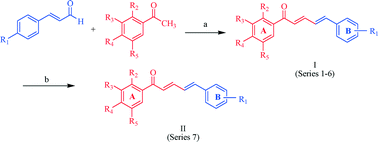Synthesis, biological evaluation and QSAR studies of diarylpentanoid analogues as potential nitric oxideinhibitors
Abstract
A series of forty-five

* Corresponding authors
a
Laboratory of Natural Products, Institute of Bioscience, Universiti Putra Malaysia, Serdang, Selangor, Malaysia
E-mail:
faridah_abas@upm.edu.my, nordinlajis@gmail.com
b Department of Chemistry, Faculty of Science, Universiti Putra Malaysia, Serdang, Selangor, Malaysia
c Department of Food Science, Faculty of Food Science and Technology, Universiti Putra Malaysia, Serdang, Selangor, Malaysia
d Drug and Herbal Research Centre Faculty of Pharmacy, Universiti Kebangsaan Malaysia, Jalan Raja Muda Abd. Aziz, Kuala Lumpur, Selangor, Malaysia
e Department of Biochemistry, Faculty of Biotechnology and Biomolecular Sciences, Universiti Putra Malaysia, Serdang, Selangor, Malaysia
f Department of Biomedical Science, Faculty of Medicine and Health Sciences, Universiti Putra Malaysia, Serdang, Selangor, Malaysia
A series of forty-five

 Please wait while we load your content...
Something went wrong. Try again?
Please wait while we load your content...
Something went wrong. Try again?
S. M. Mohd Faudzi, S. W. Leong, F. Abas, M. F. F. Mohd Aluwi, K. Rullah, K. W. Lam, S. Ahmad, C. L. Tham, K. Shaari and N. H. Lajis, Med. Chem. Commun., 2015, 6, 1069 DOI: 10.1039/C4MD00541D
To request permission to reproduce material from this article, please go to the Copyright Clearance Center request page.
If you are an author contributing to an RSC publication, you do not need to request permission provided correct acknowledgement is given.
If you are the author of this article, you do not need to request permission to reproduce figures and diagrams provided correct acknowledgement is given. If you want to reproduce the whole article in a third-party publication (excluding your thesis/dissertation for which permission is not required) please go to the Copyright Clearance Center request page.
Read more about how to correctly acknowledge RSC content.
 Fetching data from CrossRef.
Fetching data from CrossRef.
This may take some time to load.
Loading related content
